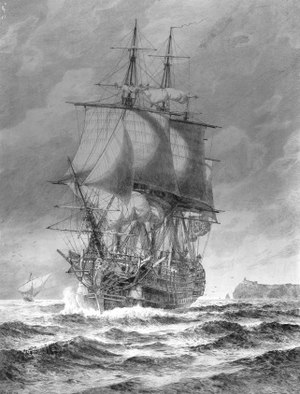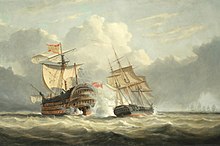Spanish shipNuestra Señora de la Santísima Trinidad
 Santísima Trinidad
| |
| History | |
|---|---|
| Name | Nuestra Señora de la Santísima Trinidad |
| Namesake | Holy Trinity |
| Ordered | 23 October 1767 |
| Builder | Havana,Cuba |
| Laid down | October 1767 |
| Launched | 20 March 1769 |
| Completed | August 1769 |
| Commissioned | 1 December 1769 |
| Homeport | Cádiz,Spain |
| Fate | Captured atTrafalgar,21 October 1805; scuttled 22 October. |
| General characteristics | |
| Class and type | 140-gunfirst-rate |
| Displacement | 4,950tons |
| Length | 61.3m(201ft) |
| Beam | 16.2 m (53 ft) |
| Draught | 8.02 m (26.3 ft) |
| Troops | ≈140 |
| Complement | 1,050 crewmen |
| Armament | |
Nuestra Señora de la Santísima Trinidad,nicknamedLa Real,sometimes confused with the merchant galleonSantísima Trinidad y Nuestra Señora del Buen Fin) was a Spanishfirst-rateship of the lineand was the largest warship in the world when launched. She originally had 112 guns; this was increased in 1795–96 to 130 guns by closing in thespar deckbetween thequarterdeckandforecastle,and to 136 guns around 1802 (plus 4 small guns on the poop), thus creating what was in effect a continuous fourth gundeck although the extra guns added were actually relatively small. She was the heaviest-armed ship in the world when rebuilt, and bore the most guns of anyship of the lineoutfitted in theAge of Sail.
Design and construction[edit]
She was built atHavana,Cuba, to a design by Irishnaval architectMatthew Mullan (domiciled in Spain under the name Mateo Mullán), originally intended as a ship of 112 guns. He died on 25 November 1767, and the construction of the ship was continued by his son, Ignacio Mullán. The ship was launched in March 1769 and completed in August 1769 as a 116-gunthree-decker.[1]She was considerably larger than her British contemporaryVictoryand somewhat bigger than the FrenchBretagne.
There is no complete plan of the ship in existence,[dubious–discuss]but there are of the 112-gun ship from 1765, from which the original dimensions of the ship may be found. Here, the units of length are the Spanish Burgos foot (27.86 cm) and the SI metre (100 cm), respectively: length = 2132⁄3(59.53); keel = 1825⁄12(50.82); beam = 573⁄4(16.09); draught = 2811⁄12(8.06).[Note 1]
She was reputed to be the largest warship in the world, for which she wasnicknamedEl Escorialde los maresby the Spanish, until surpassed in sheer size by thenew type French 120-gun shipssuch asOcéan(1790)andOrient(1791).In 1795, herforecastlewas joined to herquarterdeckto create a fourth deck containing a battery of eight pounder guns, giving her a total of 130 guns. Her armament seems to have been quickly reduced to 130 from 136 guns, but she still carried more guns than any other ship of her time.
The weight of the additional guns, so high above her waterline, made her poor sailing qualities even worse, leading to her other nicknameEl Ponderoso.[2]Some naval officers suggested that she should be restricted to defending theBay of Cádiz.
Santísima Trinidadremains notable as one of the few four-deckerships of the lineever built. TheU.S. Navyconstructed the four-deck, 136-gunPennsylvaniaand theFrench Navy,the 120-gunValmy,(both with similar flush deck arrangement). TheRoyal Navyplanned — but did not build — the 170-gun four-deckerDuke of Kent.
Service[edit]
In July 1779,Spaindeclared war onGreat Britain,joiningFrancein support of the American colonists in theAmerican War of Independence.Santísima Trinidadbecame the flagship of the Spanish fleet, taking part in theFranco-Spanish operationsin theEnglish Channelin the late summer of that year.[citation needed]
On12 August 1780she took part in the capture of 55 merchant ships from a convoy of 63, escorted by theship of the lineHMSRamilliesand three frigates.[3]In 1782 she was incorporated into the Mediterranean Squadron, participating in theGreat Siege of Gibraltarand she fought in the brief and indecisiveBattle of Cape Spartel.[citation needed]In 1795, she was modified by the addition of extra 8-pounder guns on a new deck between herforecastleandquarterdeck.[citation needed]

In 1797, she was theflagshipofTeniente GeneralJosé de Córdoba y Ramos,theSpanishcommander, atBattle of Cape St Vincenton 14 February 1797, where she was badly damaged and nearly captured by the British fleet. She was first in action with the British shipCaptain(74), commanded by CommodoreNelson,andCulloden(74). She was then attacked by theBlenheim(90),Orion(74),Irresistible(74) andExcellent(74). By now she was severely damaged, having lost all her masts and with half of her crew killed or wounded. Shestruck her colours,but the British failed to take possession and she was saved by theInfante don Pelayo(74) andPríncipe de Asturias(112).

Several days later,Santísima Trinidadwas spotted, still damaged, making her way back to Spain, and engaged by the 32-gun frigateHMSTerpsichoreunder CaptainRichard Bowen,but she escaped. She eventually returned toCadizfor repairs.[citation needed]
Eight years later, commanded by Francisco Javier Uriarte and the flagship ofRear AdmiralBaltasar Hidalgo de Cisneros,she took part in theBattle of Trafalgaron October 21, 1805, as part of the combined Franco-Spanish fleet. Due to her great bulk, her helm was unresponsive in the light winds on the day, contributing to her ineffective service in the combined fleet's cause.[citation needed]Her great size and position immediately ahead of the fleet flagshipBucentauremade her a target for the British fleet, and she came under concentrated attack by several ships, even though it managed to engage seven enemy vessels and inflict impressive casualties to the British flagship. She lost her mast and eventually surrendered with 200 dead and a hundred wounded to theNeptune,a 98-gun second rate commanded byCaptainThomas Fremantle.She was taken in tow by the 98-gun second ratePrince,[4]but was eventually scuttled by her British captors northwest of Cádiz.[5][6]
It is possible that her wreck was found by coincidence during testing of a new sidescan sonar of the Spanish Navy, in 2009.[7]An earlier attempt to find her wreck was inconclusive as lack of visual evidence could not confirm the identity of the ships found.[6]
Replicas[edit]

A full-size representation[8]of theSantísima Trinidadcould be seen in the harbour ofAlicante,in Spain. It worked as a restaurant, but has been closed. To allow regeneration works to the marina area, where the ship's mooring has now become an extended boardwalk, the replica was towed outside of the harbour and left moored on the seaward side of the breakwater. Here, close to the Panoramis centre, the ship gradually became a rotting hulk, with most of the masts and rigging collapsed onto the main deck. As of summer 2024, the vessel has completely vanished. There are unsubstantiated rumours of it's being towed to Cape Verde.
A non-profit non-governmental Canadian association, the Friends ofSantísima Trinidad,[9]assisted the Office of the Historian of the City ofHavana,Cubawith the construction of a new 1:25 four-metre-long scale model ofLa Santísima Trinidad.Interior construction details are exposed on one side of the vessel, and visitors are able to use a computer interface and touch screen to take a virtual tour of the ship in Spanish, English, and French. The model is displayed in the Naval Museum of La Habana, opened in June 2008 atCastillo de la Real Fuerza,the oldest building in Cuba and the oldest stone fortress in the New World.
Notes[edit]
- ^For exact figures, and those in the General characteristics frame, see: José Cayuela Fernandez,Trafalgar, hombres y naves entre dos épocas:Ariel (2004)
Sources and references[edit]
- ^Gervasio de Artinano y de Galdacano,La Arquitectura Naval Espanola (en Madera)(Madrid 1920), p.365
- ^El Ponderoso,the ponderousis a pun onel poderoso,the powerful.
- ^Harbron, John:Trafalgar and the Spanish Navy.Conway Maritime Press, 1988, page 84.ISBN0-85177-477-6
- ^Fremont-Barnes, Gregory and Hook, Christa:Trafalgar 1805: Nelson's crowning victory.Osprey Publishing, 2005, page 23.ISBN1-84176-892-8
- ^Fremont-Barnes and Hook, page 81
- ^ab"Battle of Trafalgar, Admiral Lord Nelson's Fatal Victory".nationalgeographic.com.National Geographic Magazine. Archived fromthe originalon March 27, 2008.Retrieved5 June2017.
- ^"Have the remains of the Santísima Trinidad been discovered?".www.km.kongsberg.com.Retrieved5 June2017.
- ^"Barco restaurante Santisima Trinidad".27 May 2016.Retrieved22 Nov2019.
- ^"Friends of the Santísima Trinidad".Archived fromthe originalon 26 July 2011.
Bibliography[edit]
- Winfield, Rif; Tredrea, John M; García-Torralba Pérez, Enrique & Blasco Felip, Manuel (2023).Spanish Warships in the Age of Sail 1700—1860: Design, Construction, Careers and Fates.Barnsley, UK: Seaforth Publishing.ISBN978-1-5267-9078-1.
- John D. HarbronTrafalgar and the Spanish Navy(1988)ISBN0-87021-695-3
- José Cayuela Fernandez –Trafalgar, hombres y naves entre dos épocas– Ariel (Barcelona) 2004ISBN8434467607
External links[edit]
- More info with pictures of models
- Website of the Canadian non-profit association, pictures of the construction of the model, history facts and other eventsArchived2008-08-26 at theWayback Machine
